Traditional Contract Construction Method: Advantages & Disadvantages
VerifiedAdded on 2023/06/04
|9
|1972
|405
Report
AI Summary
This report provides an analysis of the traditional contract construction method, also known as design-bid-build, examining its advantages and disadvantages in comparison to more modern delivery systems like design-build. It discusses the roles of the client, consultant, and builder in the traditional method, highlighting the importance of contract management and risk distribution. The report also explores alternative construction methods, focusing on the design-build approach, outlining its benefits such as single-point responsibility and shortened project delivery time, as well as its drawbacks including potential loss of checks and balances and reduced owner control. The conclusion emphasizes the reliability of the traditional method under specific contract types, particularly lump sum contracts, while acknowledging the increasing adoption of alternative methods for their efficiency and integrated approach. This document is available on Desklib, a platform offering a range of study resources including past papers and solved assignments for students.
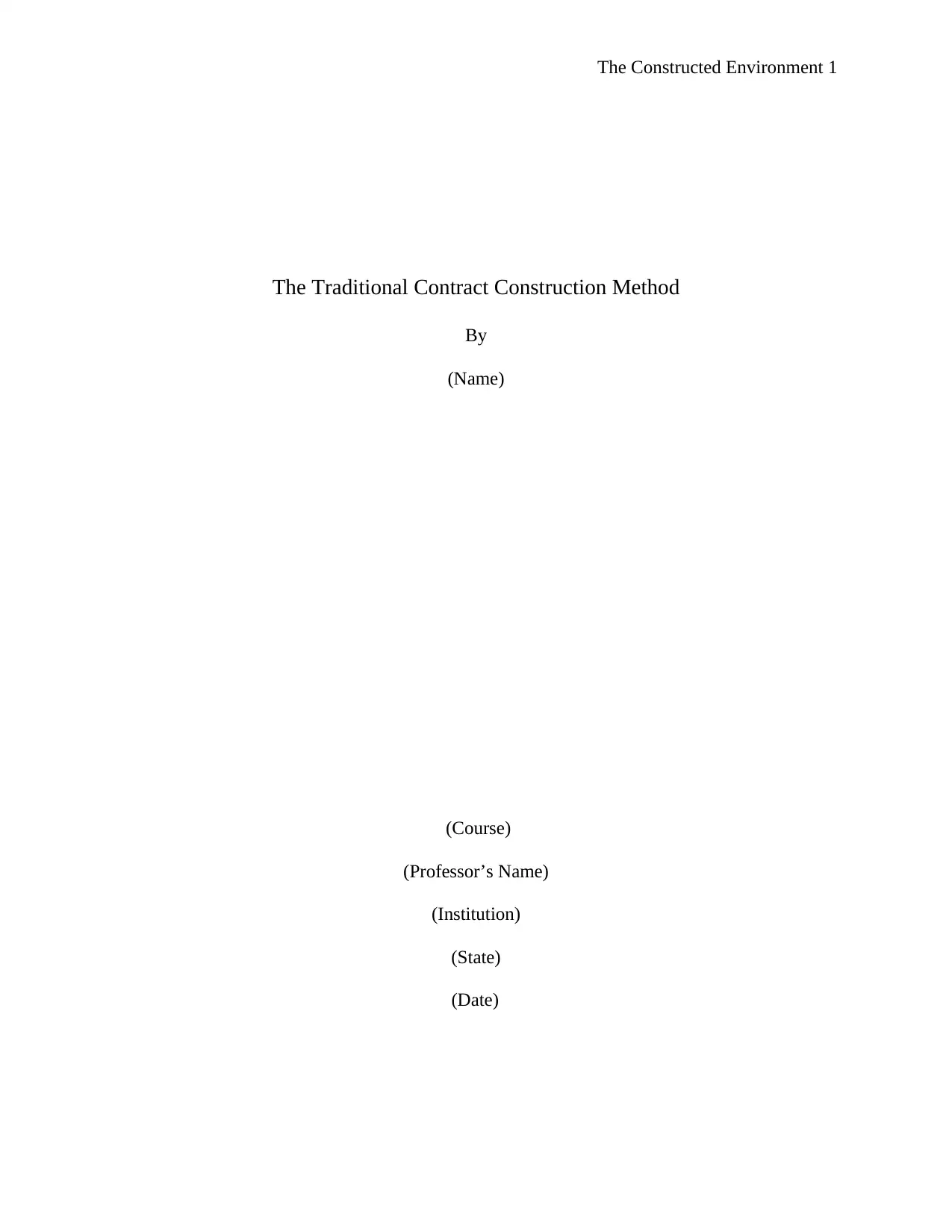
The Constructed Environment 1
The Traditional Contract Construction Method
By
(Name)
(Course)
(Professor’s Name)
(Institution)
(State)
(Date)
The Traditional Contract Construction Method
By
(Name)
(Course)
(Professor’s Name)
(Institution)
(State)
(Date)
Paraphrase This Document
Need a fresh take? Get an instant paraphrase of this document with our AI Paraphraser
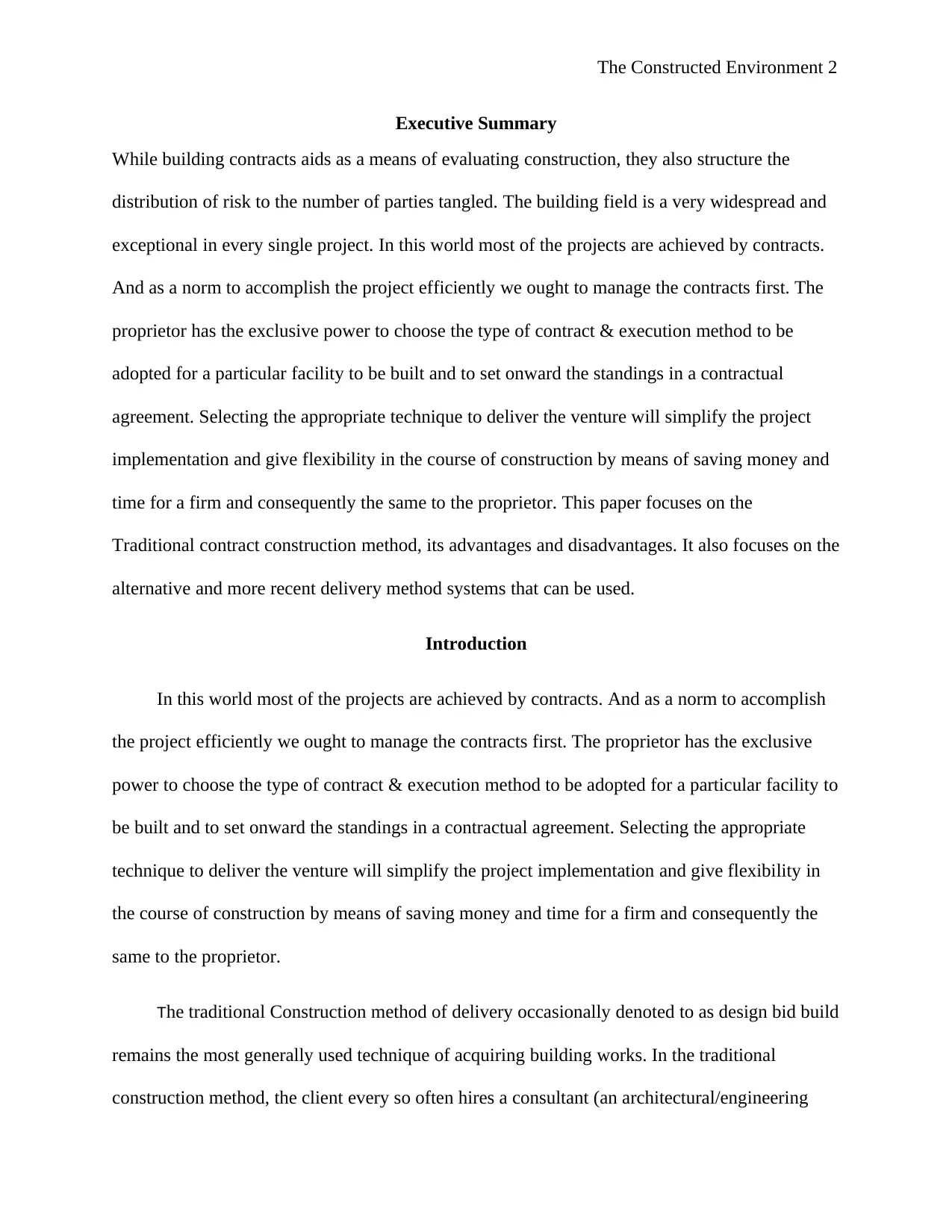
The Constructed Environment 2
Executive Summary
While building contracts aids as a means of evaluating construction, they also structure the
distribution of risk to the number of parties tangled. The building field is a very widespread and
exceptional in every single project. In this world most of the projects are achieved by contracts.
And as a norm to accomplish the project efficiently we ought to manage the contracts first. The
proprietor has the exclusive power to choose the type of contract & execution method to be
adopted for a particular facility to be built and to set onward the standings in a contractual
agreement. Selecting the appropriate technique to deliver the venture will simplify the project
implementation and give flexibility in the course of construction by means of saving money and
time for a firm and consequently the same to the proprietor. This paper focuses on the
Traditional contract construction method, its advantages and disadvantages. It also focuses on the
alternative and more recent delivery method systems that can be used.
Introduction
In this world most of the projects are achieved by contracts. And as a norm to accomplish
the project efficiently we ought to manage the contracts first. The proprietor has the exclusive
power to choose the type of contract & execution method to be adopted for a particular facility to
be built and to set onward the standings in a contractual agreement. Selecting the appropriate
technique to deliver the venture will simplify the project implementation and give flexibility in
the course of construction by means of saving money and time for a firm and consequently the
same to the proprietor.
The traditional Construction method of delivery occasionally denoted to as design bid build
remains the most generally used technique of acquiring building works. In the traditional
construction method, the client every so often hires a consultant (an architectural/engineering
Executive Summary
While building contracts aids as a means of evaluating construction, they also structure the
distribution of risk to the number of parties tangled. The building field is a very widespread and
exceptional in every single project. In this world most of the projects are achieved by contracts.
And as a norm to accomplish the project efficiently we ought to manage the contracts first. The
proprietor has the exclusive power to choose the type of contract & execution method to be
adopted for a particular facility to be built and to set onward the standings in a contractual
agreement. Selecting the appropriate technique to deliver the venture will simplify the project
implementation and give flexibility in the course of construction by means of saving money and
time for a firm and consequently the same to the proprietor. This paper focuses on the
Traditional contract construction method, its advantages and disadvantages. It also focuses on the
alternative and more recent delivery method systems that can be used.
Introduction
In this world most of the projects are achieved by contracts. And as a norm to accomplish
the project efficiently we ought to manage the contracts first. The proprietor has the exclusive
power to choose the type of contract & execution method to be adopted for a particular facility to
be built and to set onward the standings in a contractual agreement. Selecting the appropriate
technique to deliver the venture will simplify the project implementation and give flexibility in
the course of construction by means of saving money and time for a firm and consequently the
same to the proprietor.
The traditional Construction method of delivery occasionally denoted to as design bid build
remains the most generally used technique of acquiring building works. In the traditional
construction method, the client every so often hires a consultant (an architectural/engineering
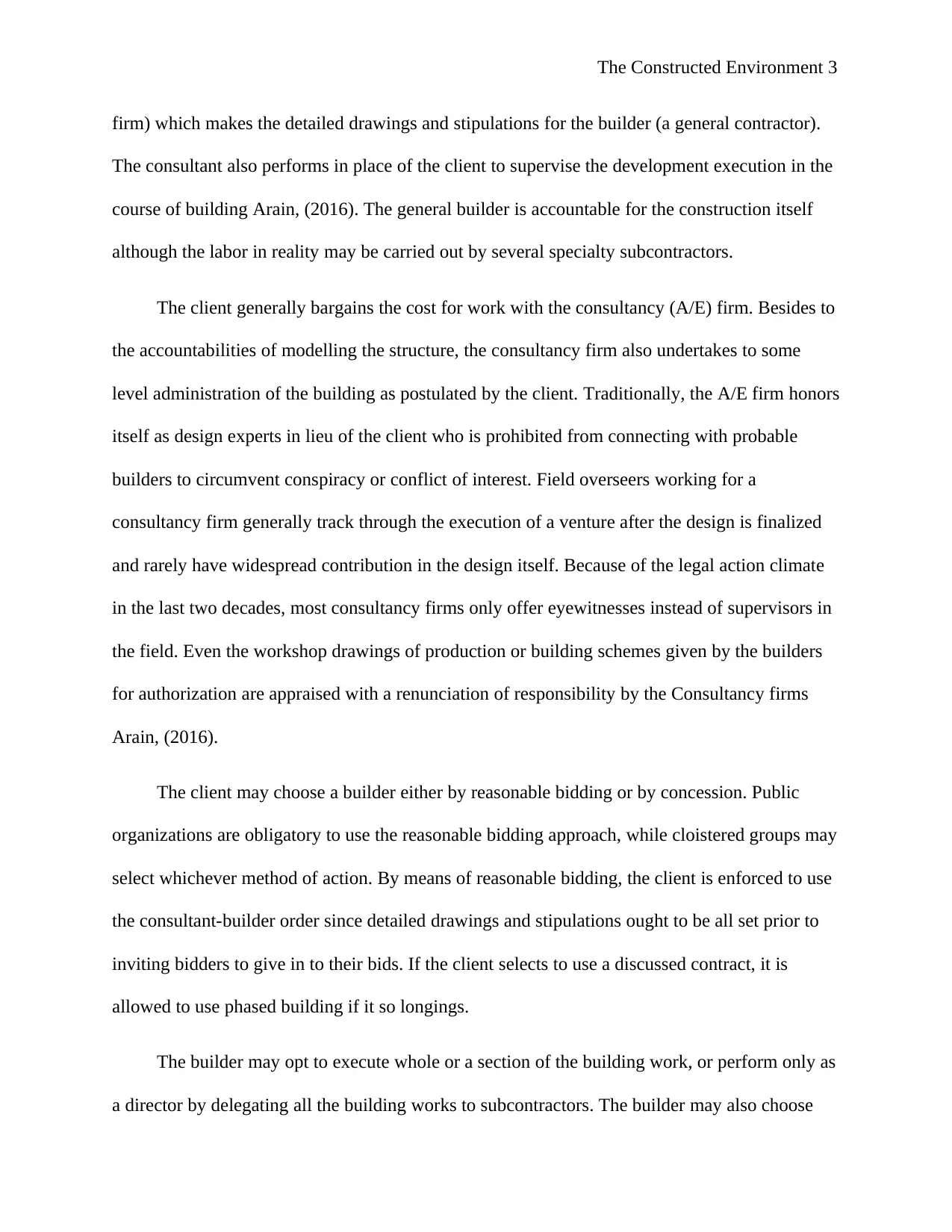
The Constructed Environment 3
firm) which makes the detailed drawings and stipulations for the builder (a general contractor).
The consultant also performs in place of the client to supervise the development execution in the
course of building Arain, (2016). The general builder is accountable for the construction itself
although the labor in reality may be carried out by several specialty subcontractors.
The client generally bargains the cost for work with the consultancy (A/E) firm. Besides to
the accountabilities of modelling the structure, the consultancy firm also undertakes to some
level administration of the building as postulated by the client. Traditionally, the A/E firm honors
itself as design experts in lieu of the client who is prohibited from connecting with probable
builders to circumvent conspiracy or conflict of interest. Field overseers working for a
consultancy firm generally track through the execution of a venture after the design is finalized
and rarely have widespread contribution in the design itself. Because of the legal action climate
in the last two decades, most consultancy firms only offer eyewitnesses instead of supervisors in
the field. Even the workshop drawings of production or building schemes given by the builders
for authorization are appraised with a renunciation of responsibility by the Consultancy firms
Arain, (2016).
The client may choose a builder either by reasonable bidding or by concession. Public
organizations are obligatory to use the reasonable bidding approach, while cloistered groups may
select whichever method of action. By means of reasonable bidding, the client is enforced to use
the consultant-builder order since detailed drawings and stipulations ought to be all set prior to
inviting bidders to give in to their bids. If the client selects to use a discussed contract, it is
allowed to use phased building if it so longings.
The builder may opt to execute whole or a section of the building work, or perform only as
a director by delegating all the building works to subcontractors. The builder may also choose
firm) which makes the detailed drawings and stipulations for the builder (a general contractor).
The consultant also performs in place of the client to supervise the development execution in the
course of building Arain, (2016). The general builder is accountable for the construction itself
although the labor in reality may be carried out by several specialty subcontractors.
The client generally bargains the cost for work with the consultancy (A/E) firm. Besides to
the accountabilities of modelling the structure, the consultancy firm also undertakes to some
level administration of the building as postulated by the client. Traditionally, the A/E firm honors
itself as design experts in lieu of the client who is prohibited from connecting with probable
builders to circumvent conspiracy or conflict of interest. Field overseers working for a
consultancy firm generally track through the execution of a venture after the design is finalized
and rarely have widespread contribution in the design itself. Because of the legal action climate
in the last two decades, most consultancy firms only offer eyewitnesses instead of supervisors in
the field. Even the workshop drawings of production or building schemes given by the builders
for authorization are appraised with a renunciation of responsibility by the Consultancy firms
Arain, (2016).
The client may choose a builder either by reasonable bidding or by concession. Public
organizations are obligatory to use the reasonable bidding approach, while cloistered groups may
select whichever method of action. By means of reasonable bidding, the client is enforced to use
the consultant-builder order since detailed drawings and stipulations ought to be all set prior to
inviting bidders to give in to their bids. If the client selects to use a discussed contract, it is
allowed to use phased building if it so longings.
The builder may opt to execute whole or a section of the building work, or perform only as
a director by delegating all the building works to subcontractors. The builder may also choose
⊘ This is a preview!⊘
Do you want full access?
Subscribe today to unlock all pages.

Trusted by 1+ million students worldwide
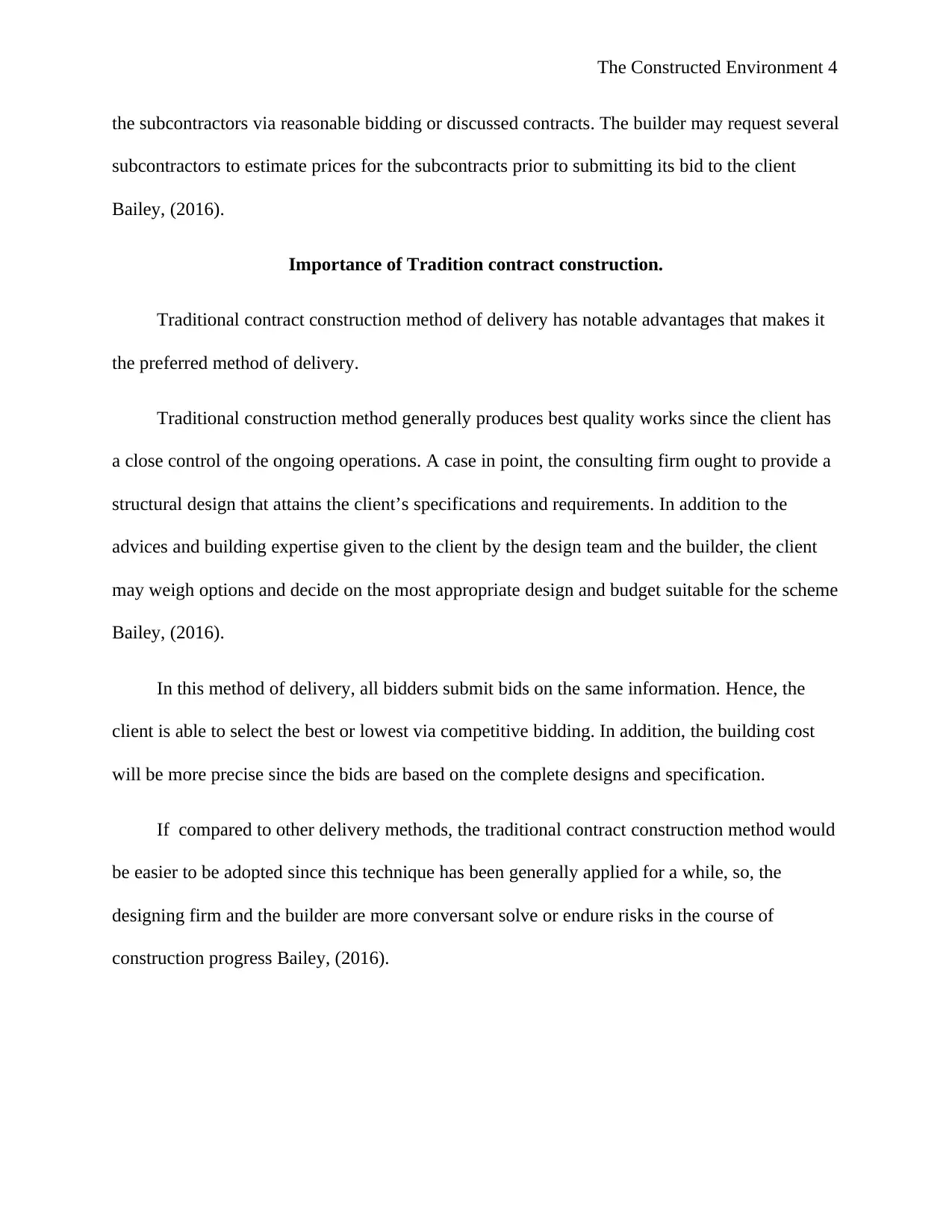
The Constructed Environment 4
the subcontractors via reasonable bidding or discussed contracts. The builder may request several
subcontractors to estimate prices for the subcontracts prior to submitting its bid to the client
Bailey, (2016).
Importance of Tradition contract construction.
Traditional contract construction method of delivery has notable advantages that makes it
the preferred method of delivery.
Traditional construction method generally produces best quality works since the client has
a close control of the ongoing operations. A case in point, the consulting firm ought to provide a
structural design that attains the client’s specifications and requirements. In addition to the
advices and building expertise given to the client by the design team and the builder, the client
may weigh options and decide on the most appropriate design and budget suitable for the scheme
Bailey, (2016).
In this method of delivery, all bidders submit bids on the same information. Hence, the
client is able to select the best or lowest via competitive bidding. In addition, the building cost
will be more precise since the bids are based on the complete designs and specification.
If compared to other delivery methods, the traditional contract construction method would
be easier to be adopted since this technique has been generally applied for a while, so, the
designing firm and the builder are more conversant solve or endure risks in the course of
construction progress Bailey, (2016).
the subcontractors via reasonable bidding or discussed contracts. The builder may request several
subcontractors to estimate prices for the subcontracts prior to submitting its bid to the client
Bailey, (2016).
Importance of Tradition contract construction.
Traditional contract construction method of delivery has notable advantages that makes it
the preferred method of delivery.
Traditional construction method generally produces best quality works since the client has
a close control of the ongoing operations. A case in point, the consulting firm ought to provide a
structural design that attains the client’s specifications and requirements. In addition to the
advices and building expertise given to the client by the design team and the builder, the client
may weigh options and decide on the most appropriate design and budget suitable for the scheme
Bailey, (2016).
In this method of delivery, all bidders submit bids on the same information. Hence, the
client is able to select the best or lowest via competitive bidding. In addition, the building cost
will be more precise since the bids are based on the complete designs and specification.
If compared to other delivery methods, the traditional contract construction method would
be easier to be adopted since this technique has been generally applied for a while, so, the
designing firm and the builder are more conversant solve or endure risks in the course of
construction progress Bailey, (2016).
Paraphrase This Document
Need a fresh take? Get an instant paraphrase of this document with our AI Paraphraser
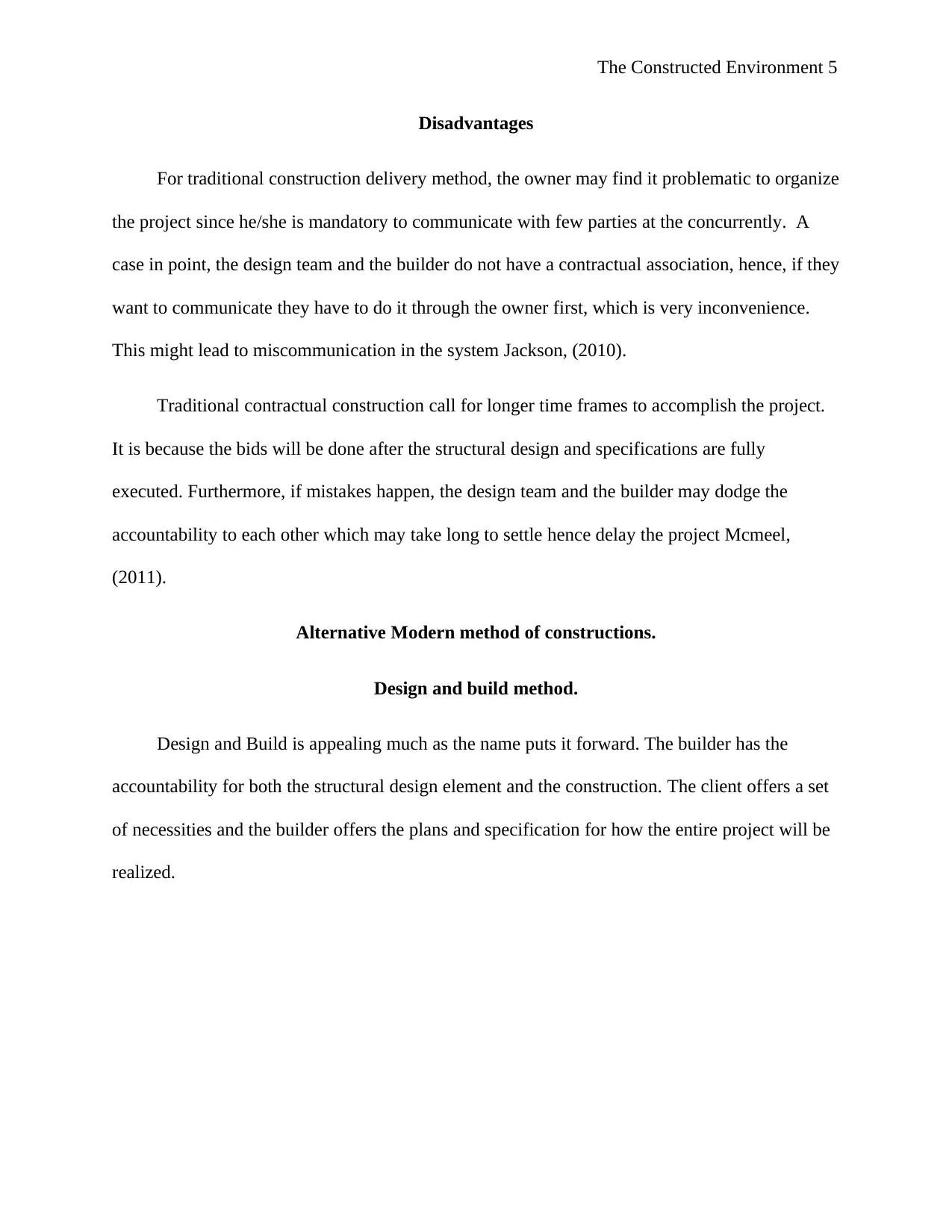
The Constructed Environment 5
Disadvantages
For traditional construction delivery method, the owner may find it problematic to organize
the project since he/she is mandatory to communicate with few parties at the concurrently. A
case in point, the design team and the builder do not have a contractual association, hence, if they
want to communicate they have to do it through the owner first, which is very inconvenience.
This might lead to miscommunication in the system Jackson, (2010).
Traditional contractual construction call for longer time frames to accomplish the project.
It is because the bids will be done after the structural design and specifications are fully
executed. Furthermore, if mistakes happen, the design team and the builder may dodge the
accountability to each other which may take long to settle hence delay the project Mcmeel,
(2011).
Alternative Modern method of constructions.
Design and build method.
Design and Build is appealing much as the name puts it forward. The builder has the
accountability for both the structural design element and the construction. The client offers a set
of necessities and the builder offers the plans and specification for how the entire project will be
realized.
Disadvantages
For traditional construction delivery method, the owner may find it problematic to organize
the project since he/she is mandatory to communicate with few parties at the concurrently. A
case in point, the design team and the builder do not have a contractual association, hence, if they
want to communicate they have to do it through the owner first, which is very inconvenience.
This might lead to miscommunication in the system Jackson, (2010).
Traditional contractual construction call for longer time frames to accomplish the project.
It is because the bids will be done after the structural design and specifications are fully
executed. Furthermore, if mistakes happen, the design team and the builder may dodge the
accountability to each other which may take long to settle hence delay the project Mcmeel,
(2011).
Alternative Modern method of constructions.
Design and build method.
Design and Build is appealing much as the name puts it forward. The builder has the
accountability for both the structural design element and the construction. The client offers a set
of necessities and the builder offers the plans and specification for how the entire project will be
realized.
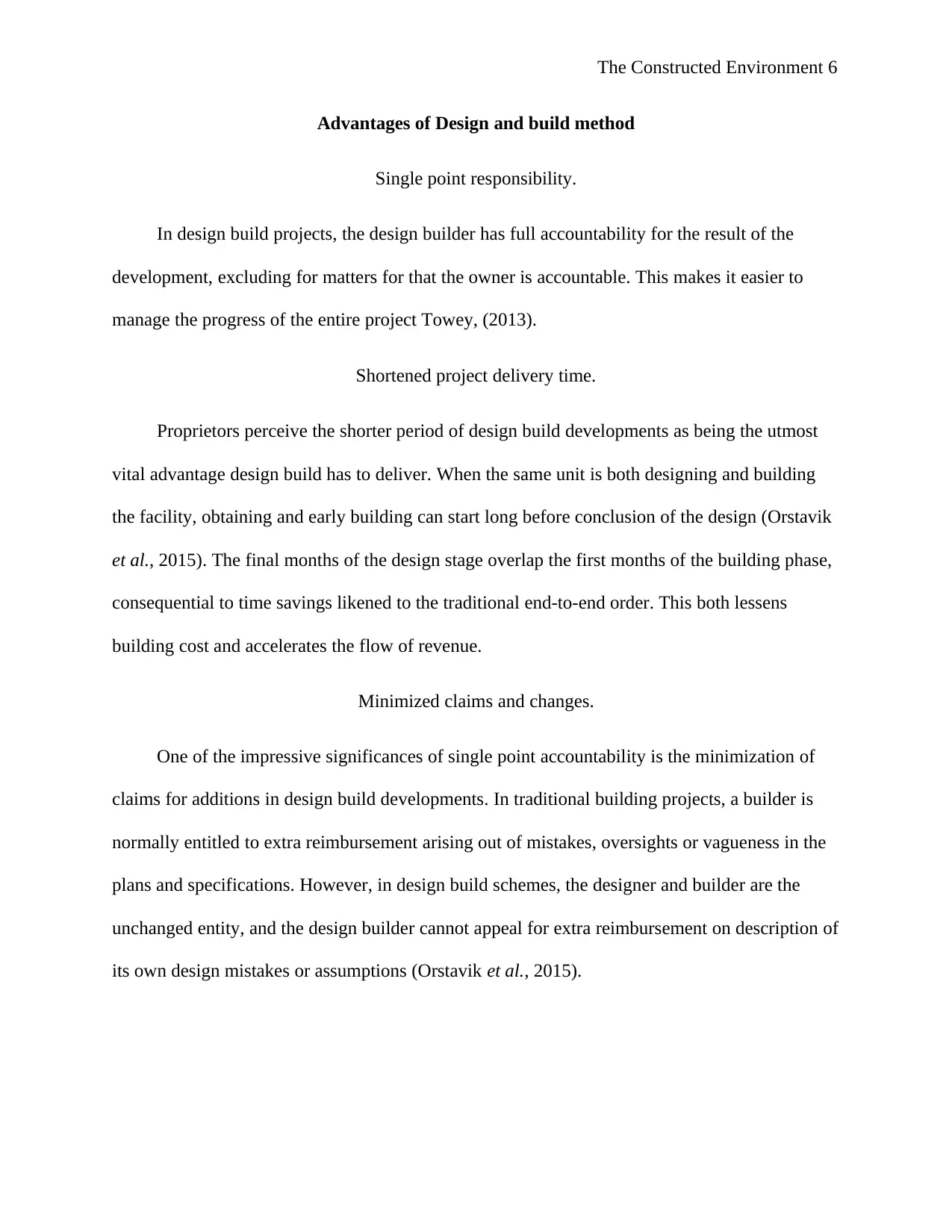
The Constructed Environment 6
Advantages of Design and build method
Single point responsibility.
In design build projects, the design builder has full accountability for the result of the
development, excluding for matters for that the owner is accountable. This makes it easier to
manage the progress of the entire project Towey, (2013).
Shortened project delivery time.
Proprietors perceive the shorter period of design build developments as being the utmost
vital advantage design build has to deliver. When the same unit is both designing and building
the facility, obtaining and early building can start long before conclusion of the design (Orstavik
et al., 2015). The final months of the design stage overlap the first months of the building phase,
consequential to time savings likened to the traditional end-to-end order. This both lessens
building cost and accelerates the flow of revenue.
Minimized claims and changes.
One of the impressive significances of single point accountability is the minimization of
claims for additions in design build developments. In traditional building projects, a builder is
normally entitled to extra reimbursement arising out of mistakes, oversights or vagueness in the
plans and specifications. However, in design build schemes, the designer and builder are the
unchanged entity, and the design builder cannot appeal for extra reimbursement on description of
its own design mistakes or assumptions (Orstavik et al., 2015).
Advantages of Design and build method
Single point responsibility.
In design build projects, the design builder has full accountability for the result of the
development, excluding for matters for that the owner is accountable. This makes it easier to
manage the progress of the entire project Towey, (2013).
Shortened project delivery time.
Proprietors perceive the shorter period of design build developments as being the utmost
vital advantage design build has to deliver. When the same unit is both designing and building
the facility, obtaining and early building can start long before conclusion of the design (Orstavik
et al., 2015). The final months of the design stage overlap the first months of the building phase,
consequential to time savings likened to the traditional end-to-end order. This both lessens
building cost and accelerates the flow of revenue.
Minimized claims and changes.
One of the impressive significances of single point accountability is the minimization of
claims for additions in design build developments. In traditional building projects, a builder is
normally entitled to extra reimbursement arising out of mistakes, oversights or vagueness in the
plans and specifications. However, in design build schemes, the designer and builder are the
unchanged entity, and the design builder cannot appeal for extra reimbursement on description of
its own design mistakes or assumptions (Orstavik et al., 2015).
⊘ This is a preview!⊘
Do you want full access?
Subscribe today to unlock all pages.

Trusted by 1+ million students worldwide
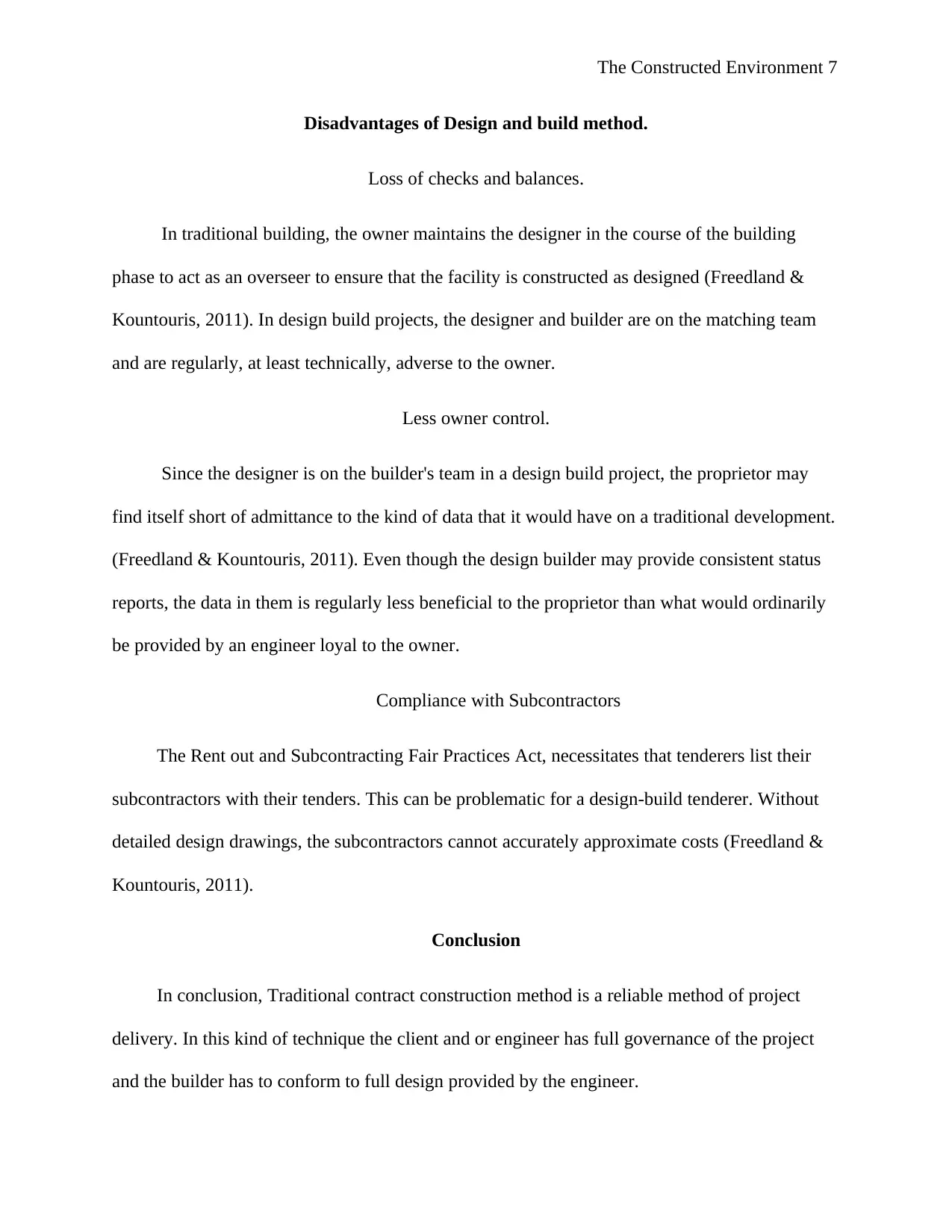
The Constructed Environment 7
Disadvantages of Design and build method.
Loss of checks and balances.
In traditional building, the owner maintains the designer in the course of the building
phase to act as an overseer to ensure that the facility is constructed as designed (Freedland &
Kountouris, 2011). In design build projects, the designer and builder are on the matching team
and are regularly, at least technically, adverse to the owner.
Less owner control.
Since the designer is on the builder's team in a design build project, the proprietor may
find itself short of admittance to the kind of data that it would have on a traditional development.
(Freedland & Kountouris, 2011). Even though the design builder may provide consistent status
reports, the data in them is regularly less beneficial to the proprietor than what would ordinarily
be provided by an engineer loyal to the owner.
Compliance with Subcontractors
The Rent out and Subcontracting Fair Practices Act, necessitates that tenderers list their
subcontractors with their tenders. This can be problematic for a design-build tenderer. Without
detailed design drawings, the subcontractors cannot accurately approximate costs (Freedland &
Kountouris, 2011).
Conclusion
In conclusion, Traditional contract construction method is a reliable method of project
delivery. In this kind of technique the client and or engineer has full governance of the project
and the builder has to conform to full design provided by the engineer.
Disadvantages of Design and build method.
Loss of checks and balances.
In traditional building, the owner maintains the designer in the course of the building
phase to act as an overseer to ensure that the facility is constructed as designed (Freedland &
Kountouris, 2011). In design build projects, the designer and builder are on the matching team
and are regularly, at least technically, adverse to the owner.
Less owner control.
Since the designer is on the builder's team in a design build project, the proprietor may
find itself short of admittance to the kind of data that it would have on a traditional development.
(Freedland & Kountouris, 2011). Even though the design builder may provide consistent status
reports, the data in them is regularly less beneficial to the proprietor than what would ordinarily
be provided by an engineer loyal to the owner.
Compliance with Subcontractors
The Rent out and Subcontracting Fair Practices Act, necessitates that tenderers list their
subcontractors with their tenders. This can be problematic for a design-build tenderer. Without
detailed design drawings, the subcontractors cannot accurately approximate costs (Freedland &
Kountouris, 2011).
Conclusion
In conclusion, Traditional contract construction method is a reliable method of project
delivery. In this kind of technique the client and or engineer has full governance of the project
and the builder has to conform to full design provided by the engineer.
Paraphrase This Document
Need a fresh take? Get an instant paraphrase of this document with our AI Paraphraser
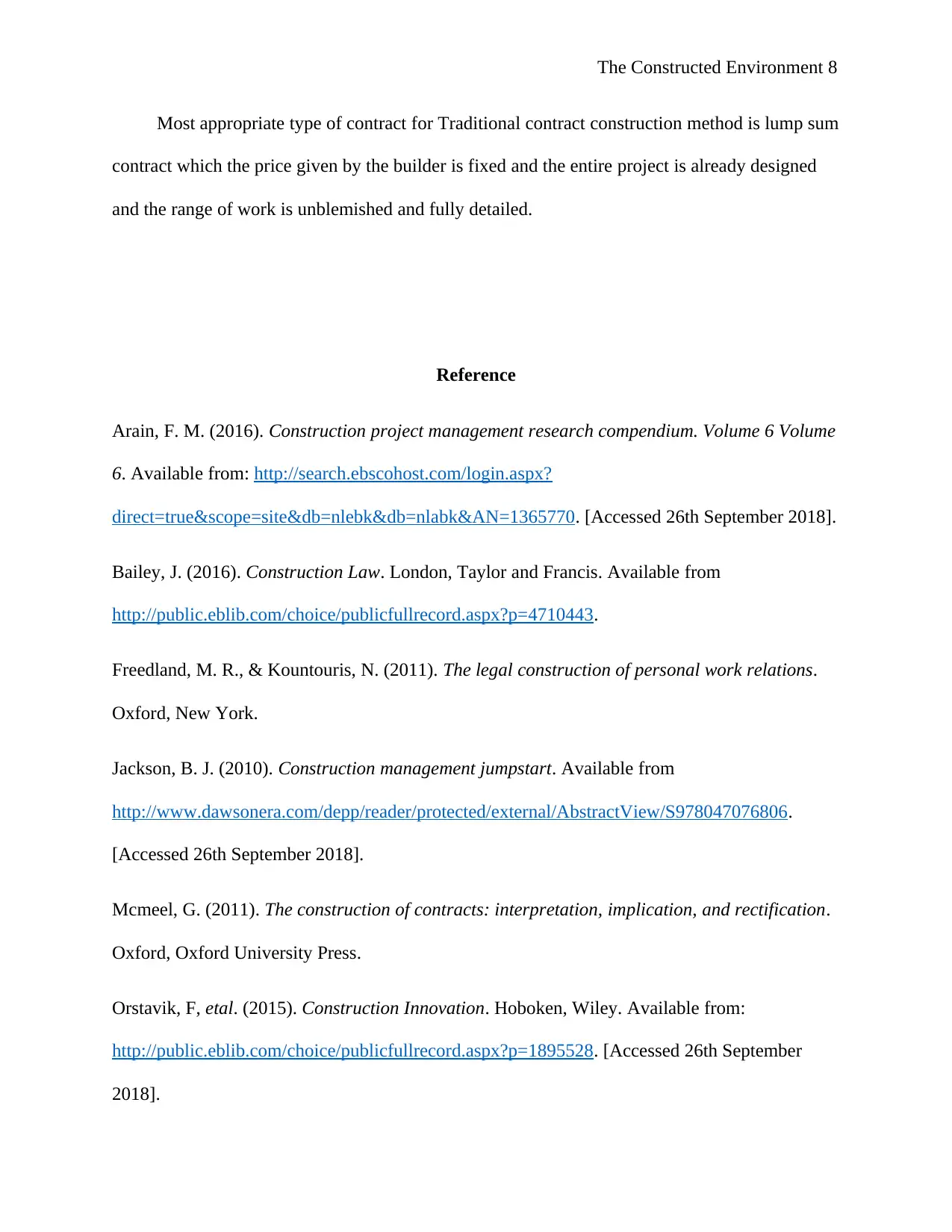
The Constructed Environment 8
Most appropriate type of contract for Traditional contract construction method is lump sum
contract which the price given by the builder is fixed and the entire project is already designed
and the range of work is unblemished and fully detailed.
Reference
Arain, F. M. (2016). Construction project management research compendium. Volume 6 Volume
6. Available from: http://search.ebscohost.com/login.aspx?
direct=true&scope=site&db=nlebk&db=nlabk&AN=1365770. [Accessed 26th September 2018].
Bailey, J. (2016). Construction Law. London, Taylor and Francis. Available from
http://public.eblib.com/choice/publicfullrecord.aspx?p=4710443.
Freedland, M. R., & Kountouris, N. (2011). The legal construction of personal work relations.
Oxford, New York.
Jackson, B. J. (2010). Construction management jumpstart. Available from
http://www.dawsonera.com/depp/reader/protected/external/AbstractView/S978047076806.
[Accessed 26th September 2018].
Mcmeel, G. (2011). The construction of contracts: interpretation, implication, and rectification.
Oxford, Oxford University Press.
Orstavik, F, etal. (2015). Construction Innovation. Hoboken, Wiley. Available from:
http://public.eblib.com/choice/publicfullrecord.aspx?p=1895528. [Accessed 26th September
2018].
Most appropriate type of contract for Traditional contract construction method is lump sum
contract which the price given by the builder is fixed and the entire project is already designed
and the range of work is unblemished and fully detailed.
Reference
Arain, F. M. (2016). Construction project management research compendium. Volume 6 Volume
6. Available from: http://search.ebscohost.com/login.aspx?
direct=true&scope=site&db=nlebk&db=nlabk&AN=1365770. [Accessed 26th September 2018].
Bailey, J. (2016). Construction Law. London, Taylor and Francis. Available from
http://public.eblib.com/choice/publicfullrecord.aspx?p=4710443.
Freedland, M. R., & Kountouris, N. (2011). The legal construction of personal work relations.
Oxford, New York.
Jackson, B. J. (2010). Construction management jumpstart. Available from
http://www.dawsonera.com/depp/reader/protected/external/AbstractView/S978047076806.
[Accessed 26th September 2018].
Mcmeel, G. (2011). The construction of contracts: interpretation, implication, and rectification.
Oxford, Oxford University Press.
Orstavik, F, etal. (2015). Construction Innovation. Hoboken, Wiley. Available from:
http://public.eblib.com/choice/publicfullrecord.aspx?p=1895528. [Accessed 26th September
2018].

The Constructed Environment 9
Towey, D. (2013). Cost Management of Construction Projects. Hoboken, Wiley. Available
from: http://public.eblib.com/choice/publicfullrecord.aspx?p=1211623. [Accessed 26th
September 2018].
Towey, D. (2013). Cost Management of Construction Projects. Hoboken, Wiley. Available
from: http://public.eblib.com/choice/publicfullrecord.aspx?p=1211623. [Accessed 26th
September 2018].
⊘ This is a preview!⊘
Do you want full access?
Subscribe today to unlock all pages.

Trusted by 1+ million students worldwide
1 out of 9
Related Documents
Your All-in-One AI-Powered Toolkit for Academic Success.
+13062052269
info@desklib.com
Available 24*7 on WhatsApp / Email
![[object Object]](/_next/static/media/star-bottom.7253800d.svg)
Unlock your academic potential
Copyright © 2020–2025 A2Z Services. All Rights Reserved. Developed and managed by ZUCOL.





